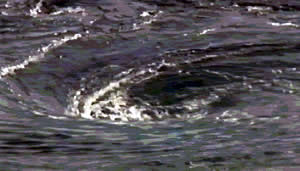One of the world's strongest "maelstroms," or giant whirlpools, is located on the coast of Norway, just north of the Arctic Circle.
The Saltstraumen, as it's known, has long been the subject of Norse legends and stories, this formidable current, the strongest tidal current in the world, was once believed to be caused by a sulphurous underground fire that alternately sucked water deep into the earth at great speed and then violently ejected it.
We know now that the Saltstraumen is generated by powerful currents that rip through channels connecting two large fjords. There are three channels. The northern and southern ones are rarely used for ship traffic. The third or center channel, the Storstraum, is the most important connection between the two fjords, both for traffic and for water masses. And this is where the maelstrom occurs.
The Storstraum channel has a minimum depth of 300 feet and is about 2000 yards long and 150 yards wide at its narrowest point. During spring tide periods of peak velocity, the current reaches more than 10 miles per hour. During the six-hour cycle of an ordinary spring tide, it has been calculated that 100 million cubic yards of water flow through this channel.
The surging currents that create the Saltstraumen vary with the phases of the Moon. During new and full moon, the current is strongest; it is weakest during the first and last quarters.
Westerly and southwesterly winds also play a part in the Saltstraumen's performance. When they blow strongest, larger masses of water are forced through the channel.
 Four times a day, when the tides change, a tremendous amount of water races through the restricted waterway with the roar of a huge cataract. The noise can be heard for several miles. The sea takes on an appearance of fullness, like a water-filled cup on the verge of overflowing. Hundreds of small whirlpools begin to form. They grow larger and larger, gathering speed. Some of them reach 30 feet in diameter and are often 25 or 30 feet deep. Legends have it that some of the whirlpools are "bottomless," and their black depths do give that impression. As the water whirls, the air above it also begins to move, producing an eerie, moaning sound.
Four times a day, when the tides change, a tremendous amount of water races through the restricted waterway with the roar of a huge cataract. The noise can be heard for several miles. The sea takes on an appearance of fullness, like a water-filled cup on the verge of overflowing. Hundreds of small whirlpools begin to form. They grow larger and larger, gathering speed. Some of them reach 30 feet in diameter and are often 25 or 30 feet deep. Legends have it that some of the whirlpools are "bottomless," and their black depths do give that impression. As the water whirls, the air above it also begins to move, producing an eerie, moaning sound.
A signal station is located at each end of the channel - and with good reason. When the Saltstraumen flows at its strongest, it can be dangerous. Boats and ships make no headway against it.
In 1905 the Swedish iron-ore ship Heros tried to navigate the Saltstraumen despite the warning signal from the station at the end of the channel. The captain tried to turn back, but his ship was swept against a small island. The crew managed to scramble onto the island, but in a short time the ship broke up and the wreckage was swept away by the current.
Many kinds of sea life are carried by this current-herring, mackerel, crabs. Lying in wait for the smaller fishes is the coalfish, a member of the cod family. With all this ready food at hand, the coalfish's flesh becomes very tasty. Then, too, the constant battle with the current makes the flesh firm and well knit. The coalfish, a popular food fish in this part of the world, has been known to grow to a length of four feet.
Maelstroms occur in many other parts of the world. Among the best known are the whirlpools in the Naruto Strait of Japan's Inland Sea and those in the Strait of Messina between Sicily and the southwestern tip of Italy. The Messina Strait maelstrom is the fearsome "Charybdis" of Homeric legend. Ancient Greek sailors believed Charybdis to be a female sea monster who devoured men and ships as they attempted to pass the rock of Scylla on what is now the Italian coast.
The legendary power of maelstroms to suck boats and ships to their doom at the bottom of the sea has been embellished by sailors' tales and fiction writers for centuries. Actually the downward suction of the maelstrom is relatively weak, and most maelstrom accidents are caused by powerful tidal currents that sweep small craft against rocks and shoals.
Nevertheless, our fascination with this awesome phenomenon continues as strong as ever. During Norway's tourist season, people arrive at the Saltstraumen in cars, on bicycles and on foot, laden with video cameras and fishing rods. A cafe is located on a strategic point and wide windows face the maelstrom. On cold days people sit at the tables, drink coffee and watch the water. The Saltstraumen is a spectacular sight at any time, but in stormy weather, when the clouds are darkening with rain and wind, the sight of the wild whirlpools is one that can never be forgotten.